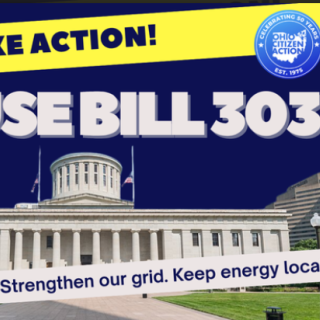Advertisement
Discussions regarding the effect our actions have on the environment are becoming a regular feature of contemporary life. Students of Ohio are joining their peers around the planet by participating in climate strikes, and between 2005 and 2015 the state’s electric power sector cut carbon emissions by 50 million metric tons per year. We are increasingly looking toward the possibilities offered by the electric vehicle (EV) industry to understand how individuals can have more of an impact on reducing environmental damage.
Worldwide, governments are committing to phasing out production of vehicles powered by fossil fuels. It is estimated that by 2030 approximately 30% of vehicles on US roads will be electric powered, with that number rising to 93% as we edge into the 2040s. How quickly we can adopt these technologies is dependent on a balance of manufacturers making EVs more widely accessible, governments supporting electric fuel infrastructure, and consumers’ willingness to engage with green transportation.
Advances in this sector are expected to include everything from more efficient power conversion, to convenient aspects such as fully automated driving. Despite some initial fears, it also appears as though the shift to electric vehicle manufacture may also create more jobs. How will these changes affect Ohio’s own vehicular landscape in the near future?
Electric Vehicle LegislationWhile we all enjoy the slightly futuristic elements of advanced technology, we must always be cognizant of how this might affect our social and legal framework. We’ve already seen how — from genetically modified crops, to internet privacy — the law has been sluggish in keeping up with technological advances. As electric vehicles become a common sight on our roads, we must take care to legislate appropriately.
An apparent advantage of electric vehicles is how quietly they run; without combustion technology in the engine, there’s a reduction in sound pollution alongside the exhaust-fume variety. However, this also raises genuine safety concerns about the ability for vulnerable road users, such as pedestrians and cyclists, to hear when and from what direction a vehicle is approaching. The National Highway Traffic Safety Administration has issued a requirement for all hybrid and electric vehicles to emit artificial noises by September 2020 — meaning fake engine noise could be a familiar sound on our streets before very long.
There is also the question of what constitutes fair annual fees, and whether the application of green tax incentives might be appropriate when it comes to the increasing number of electric vehicles in our midst. Recently, the state of Ohio has been debating the possibility of introducing a comparatively high yearly fee ($200 for EVs, $100 for hybrids) for owners of electric cars in order to help fund road repairs. Putting additional financial burden on EV users could affect Ohio’s ability to be an early influencer in this new technological trend — additional fees don’t tend to be an incentive for citizens to adopt environmentally friendly methods of transport.
The Practicalities of Electric DrivingThe idea that electric vehicles are becoming a more prevalent aspect of our society is quite exciting. However, in order for that prevalence to be sustainable, we must ensure that we have the infrastructure to support it. There’s little argument that embracing electric vehicles can be positive, but we need to look at whether we’re able to practically adopt this into our lifestyles.
One of the concerns that is frequently raised by EV users is how there aren’t yet sufficient charging facilities to make their vehicles as practical to use as gas counterparts. The future will need to include significant investment in convenient spaces for electric users to refuel. The Ohio House of Representatives has proposed a study (House Bill 202) examining the possibility of expanding infrastructure, including investment in vehicle charging facilities — they are expected to produce a report featuring budget recommendations before 2021.
One advanced technology that seems to be connected to discussions surrounding the rise of electric vehicle use, is the development of automated vehicles (AVs). The growing reality of automation is also raising questions about what changes need to be made to allow for the already-predicted fleets of autonomous Uber automated services. For the first time, we are having to explore the possible effects AVs represent to our driving environment, and how we can standardize our roads to make them more compatible with AV mapping and tracking systems.
The Reality of TechnologyIt can sometimes be difficult to accept that we’ve reached the point at which advances such as electric vehicles are a viable reality of contemporary society. Not to mention that it’s always encouraging to see that the car industry is willing to take protecting the environment seriously. That doesn’t mean to say that there aren’t some significant technological hurdles still to overcome before we’re all able to walk into showrooms and comfortably select an electric vehicle to take home.
While we are able to manufacture and produce the technology for electric vehicles, we’re not quite at the stage yet where it is especially affordable. It’s getting better, the price point of new electric and automated cars is beginning to edge down, and the savings drivers can make on fuel costs certainly warrant the investment in the long term. As manufacturing and parts costs become lower, it is expected that within the next 8 years or so prices of EVs will comparable to their gas counterparts, making them more accessible to the average driver.
Charging technology is also set to improve. In addition to improved access to fueling stations, Norway is currently trialling wireless induction charging stations; charging plates will be built into roads to allow vehicles to charge while parked. It is still early days for this refuelling method, but BMW is trialling the method in the US in the near future.
ConclusionThe use of electric cars is no longer the kind of futuristic flight of fancy it may have appeared just a couple of decades ago. Rather, it is now a practical example of how each of us can take independent, responsible steps to fight the onset of the catastrophic effects of climate change. Governments, manufacturers, and individual citizens need to work together to ensure the development of electric vehicles results in their easy adoption into everyday life as soon as possible in order to make the most significant impact.



